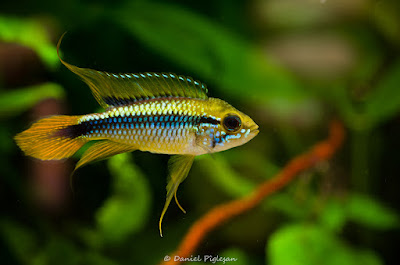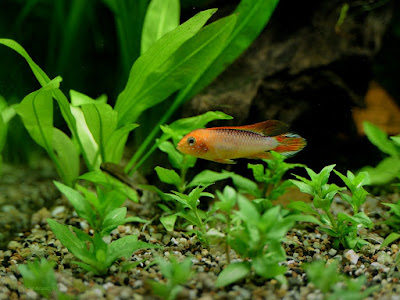Agassiz's dwarf cichlid - Apistogramma agassizii are popular due to the wide variety of color patterns that exist in the hobby...
Agassiz's dwarf cichlid, also know as Geophagus agassizii, Apistogramma parva and its scientific name Apistogramma agassizii, are popular due to the wide variety of color patterns that exist in the hobby, including Double Red, Fire Red, and various wild-types.
AGASSIZ'S DWARF CICHLID - APISTOGRAMMA AGASSIZII DESCRIPTION
Agassiz's dwarf cichlid is native to the Amazon basin. It is found and collected throughout the floodplain of the Amazon basin and lives in all types of water, including white, black, and clear, and in degraded environments. It prefers habitats with minimal current where plant debris, particularly dead leaves, accumulate as shelter from predators, both larger fishes and aerial predators.
Apistogramma agassizii can reach up to 8 cm in total length, shows sexual dimorphism in adults. They common live up to 3-5 years of lifespan in captivity, though they have been known to live as long as 12 years.
Color variations are dependant on the area where it is caught, or if it is captive bred for coloring. Wild caught fish are more colorful than the captive strains but are also more sensitive. Red, gold and blue are the color varieties that are available. Breeding a wild caught with a captive bred helps to keep the lines healthier.
Males are much larger and have elongated fins and more colours than the female who tend to be more yellow, especially when they are spawning. The male's general color description is the upper back being red and the lower back being green. There is a horizontal black band that runs from the nose straight to the tip of the tail fin, and it runs below and parallel to the green of the lower back. Coloration below the black band can run from blue to green to yellow. The belly is usually yellow. The face has gold or green marks and the forehead is yellow. The dorsal fin is an orangish red color with a sharp point at the end. The caudal fin has lines in white, light blue to blue, and comes to a point at the end. Other fins are green to blue. Females do not have the longer fins or the intense color of the males, but have a yellow coloring and similar markings.
AGASSIZ'S DWARF CICHLID - APISTOGRAMMA AGASSIZII CARE
Agassiz's dwarf cichlid is one of the easiest to keep of all the Apistogramma varieties. It is a beautiful little cichlid to watch and does very well in a heavily planted tank, minimum 20 gallons with water temperature of 24-28°C, pH level of 5.5-6.8 and general hardness of 30-100 ppm. A natural-looking arrangement might consist of a soft, sandy substrate with wood roots and branches placed such a way that plenty of shady spots and caves are formed. Ensure there are plenty of caves to hide and spawn in.
Apistogramma agassizii are a very peaceful species and make a colourful addition to most community tanks. The male however can be very protective of his females and fry, so it is recommended not to stock many bottom dwelling fish as they can be a target for the overprotective male. Like many Apistogramma species they fare better when kept at a ratio of 1 male per 3-4 females.
Do water changes of 10% to 20% biweekly or weekly, more or less depending on stocking numbers. If water quality is ignored, as with all cichlids, disease and death can occur. Make sure to clean the viewing pane throughly and let particles settle before cleaning. When refilling the tank make sure to treat the replacement water and also that the temperatures are similar to the water in the tank.
These fish are carnivorous and will take dry foods such as flake and crumble as well as frozen foods such as blood worm, and brine shrimp. They also benefit from the occasional feeding of live food such as mosquito larvae and black worm.
Feed 2 to 5 small pinches of food a day in smaller amounts rather than a large quantity once a day. This will keep the water quality higher over a longer time. All fish benefit from vitamins and supplements added to their foods.
They are susceptible to typical fish ailments, especially if water is stale and of poor quality and oxygenation. Be aware of the following diseases: Parasitic infestations (protozoa, worms, etc.) including White spot Disease known as Ich (Ichthyobodo Infection), Costia Disease, Flatworms (Metacercaria Infection), Cestoda infestation (Tapeworms), Metacercaria Infection (Flatworms), Bacterial Infections (general), Bacterial diseases, and Turbidity of the Skin (Freshwater fish). Ich is one of the more frequently encountered ailments and can be easily treated by elevating the tank temperature to 30° C for 3 days.
AGASSIZ'S DWARF CICHLID - APISTOGRAMMA AGASSIZII SPAWNING
Agassiz's dwarf cichlid are cave breeders and generally spawn 40-60 eggs. To breed they will appreciate upturned flowerpots, fake "coconut caves," bogwood, and broad leafed plants for cover and as spawning sites. The eggs tend to be prone to fungus which can make the breeding of these fish more difficult.
From the beginning of laying, the females always deposited their eggs in the shelters. The females built their nests by spreading the substrate inside the shelter and reducing the entrance, collecting the substrate with their mouths, and taking it to the opening; male passage was only allowed when spawning. At this time, the female laid the adhesive eggs, which had a U-shaped or oval body, on the concave region of the shelter, without any symmetry, and then the male fertilized them.
After spawning, the females remained longer in the shelters, exhibiting parental care, and the males displayed a territorial behavior around the shelter. Both individuals explored the territory in search of food, and the female made the shortest trips, returning quickly to the spawning site. The larvae hatched 48 h after laying, and they remained inside the nest under parental care. On the third day of life, they were already free-swimming, making forays around the shelter, closely monitored by the female, who at certain times defended them from the male’s approach.
BUY AGASSIZ'S DWARF CICHLID - APISTOGRAMMA AGASSIZII AND RELATED PRODUCTS














COMMENTS